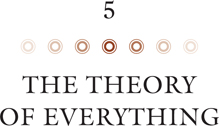

 HE UNIVERSE IS COMPREHENSIBLE because it is governed by scientific laws; that is to say, its behavior can be modeled. But what are these laws or models? The first force to be described in mathematical language was gravity. Newton’s law of gravity, published in 1687, said that every object in the universe attracts every other object with a force proportional to its mass. It made a great impression on the intellectual life of its era because it showed for the first time that at least one aspect of the universe could be accurately modeled, and it established the mathematical machinery to do so. The idea that there are laws of nature brings up issues similar to that for which Galileo had been convicted of heresy about fifty years earlier. For instance, the Bible tells the story of Joshua praying for the sun and moon to stop in their trajectories so he would have extra daylight to finish fighting the Amorites in Canaan. According to the book of Joshua, the sun stood still for about a day. Today we know that that would have meant that the earth stopped rotating. If the earth stopped, according to Newton’s laws anything not tied down would have remained in motion at the earth’s original speed (1,100 miles per hour at the equator)—a high price to pay for a delayed sunset. None of this bothered Newton himself, for as we’ve said, Newton believed that God could and did intervene in the workings of the universe.
HE UNIVERSE IS COMPREHENSIBLE because it is governed by scientific laws; that is to say, its behavior can be modeled. But what are these laws or models? The first force to be described in mathematical language was gravity. Newton’s law of gravity, published in 1687, said that every object in the universe attracts every other object with a force proportional to its mass. It made a great impression on the intellectual life of its era because it showed for the first time that at least one aspect of the universe could be accurately modeled, and it established the mathematical machinery to do so. The idea that there are laws of nature brings up issues similar to that for which Galileo had been convicted of heresy about fifty years earlier. For instance, the Bible tells the story of Joshua praying for the sun and moon to stop in their trajectories so he would have extra daylight to finish fighting the Amorites in Canaan. According to the book of Joshua, the sun stood still for about a day. Today we know that that would have meant that the earth stopped rotating. If the earth stopped, according to Newton’s laws anything not tied down would have remained in motion at the earth’s original speed (1,100 miles per hour at the equator)—a high price to pay for a delayed sunset. None of this bothered Newton himself, for as we’ve said, Newton believed that God could and did intervene in the workings of the universe.
The next aspects of the universe for which a law or model was discovered were the electric and magnetic forces. These behave like gravity, with the important difference that two electric charges or two magnets of the same kind repel each other, while unlike charges or unlike magnets attract. Electric and magnetic forces are far stronger than gravity, but we don’t usually notice them in everyday life because a macroscopic body contains almost equal numbers of positive and negative electrical charges. This means that the electric and magnetic forces between two macroscopic bodies nearly cancel each other out, unlike the gravitational forces, which all add up.
Our current ideas about electricity and magnetism were developed over a period of about a hundred years from the mid-eighteenth to the mid-nineteenth century, when physicists in several countries made detailed experimental studies of electric and magnetic forces. One of the most important discoveries was that electrical and magnetic forces are related: A moving electrical charge causes a force on magnets, and a moving magnet causes a force on electrical charges. The first to realize there was some connection was Danish physicist Hans Christian Ørsted. While setting up for a lecture he was to give at the university in 1820, Ørsted noticed that the electric current from the battery he was using deflected a nearby compass needle. He soon realized that moving electricity created a magnetic force, and coined the term “electromagnetism.” A few years later British scientist Michael Faraday reasoned that—expressed in modern terms—if an electric current could cause a magnetic field, a magnetic field should be able to produce an electric current. He demonstrated that effect in 1831. Fourteen years later Faraday also discovered a connection between electromagnetism and light when he showed that intense magnetism can affect the nature of polarized light.
Faraday had little formal education. He had been born into a poor blacksmith’s family near London and left school at age thirteen to work as an errand boy and bookbinder in a bookshop. There, over the years, he learned science by reading the books he was supposed to care for, and by performing simple and cheap experiments in his spare time. Eventually he obtained work as an assistant in the laboratory of the great chemist Sir Humphry Davy. Faraday would stay on for the remaining forty-five years of his life and, after Davy’s death, succeed him. Faraday had trouble with mathematics and never learned much of it, so it was a struggle for him to conceive a theoretical picture of the odd electromagnetic phenomena he observed in his laboratory. Nevertheless, he did.
One of Faraday’s greatest intellectual innovations was the idea of force fields. These days, thanks to books and movies about bug-eyed aliens and their starships, most people are familiar with the term, so maybe he should get a royalty. But in the centuries between Newton and Faraday one of the great mysteries of physics was that its laws seemed to indicate that forces act across the empty space that separates interacting objects. Faraday didn’t like that. He believed that to move an object, something has to come in contact with it. And so he imagined the space between electric charges and magnets as being filled with invisible tubes that physically do the pushing and pulling. Faraday called those tubes a force field. A good way to visualize a force field is to perform the schoolroom demonstration in which a glass plate is placed over a bar magnet and iron filings spread on the glass. With a few taps to overcome friction, the filings move as if nudged by an unseen power and arrange themselves in a pattern of arcs stretching from one pole of the magnet to the other. That pattern is a map of the unseen magnetic force that permeates space. Today we believe that all forces are transmitted by fields, so it is an important concept in modern physics—as well as science fiction.
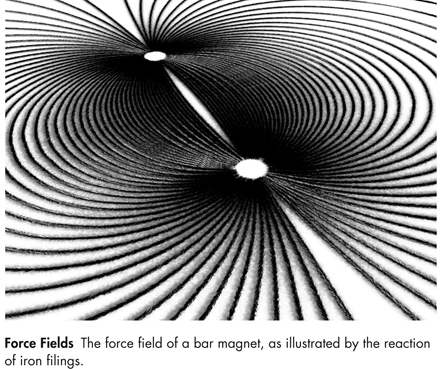
For several decades our understanding of electromagnetism remained stalled, amounting to no more than the knowledge of a few empirical laws: the hint that electricity and magnetism were closely, if mysteriously, related; the notion that they had some sort of connection to light; and the embryonic concept of fields. At least eleven theories of electromagnetism existed, every one of them flawed. Then, over a period of years in the 1860s, Scottish physicist James Clerk Maxwell developed Faraday’s thinking into a mathematical framework that explained the intimate and mysterious relation among electricity, magnetism, and light. The result was a set of equations describing both electric and magnetic forces as manifestations of the same physical entity, the electromagnetic field. Maxwell had unified electricity and magnetism into one force. Moreover, he showed that electromagnetic fields could propagate through space as a wave. The speed of that wave is governed by a number that appeared in his equations, which he calculated from experimental data that had been measured a few years earlier. To his astonishment the speed he calculated equaled the speed of light, which was then known experimentally to an accuracy of 1 percent. He had discovered that light itself is an electromagnetic wave!
Today the equations that describe electric and magnetic fields are called Maxwell’s equations. Few people have heard of them, but they are probably the most commercially important equations we know. Not only do they govern the working of everything from household appliances to computers, but they also describe waves other than light, such as microwaves, radio waves, infrared light, and X-rays. All of these differ from visible light in only one respect—their wavelength. Radio waves have wavelengths of a meter or more, while visible light has a wavelength of a few ten-millionths of a meter, and X-rays a wavelength shorter than a hundred-millionth of a meter. Our sun radiates at all wavelengths, but its radiation is most intense in the wavelengths that are visible to us. It’s probably no accident that the wavelengths we are able to see with the naked eye are those in which the sun radiates most strongly: It’s likely that our eyes evolved with the ability to detect electromagnetic radiation in that range precisely because that is the range of radiation most available to them. If we ever run into beings from other planets, they will probably have the ability to “see” radiation at whatever wavelengths their own sun emits most strongly, modulated by factors such as the light-blocking characteristics of the dust and gases in their planet’s atmosphere. So aliens who evolved in the presence of X-rays might have a nice career in airport security.
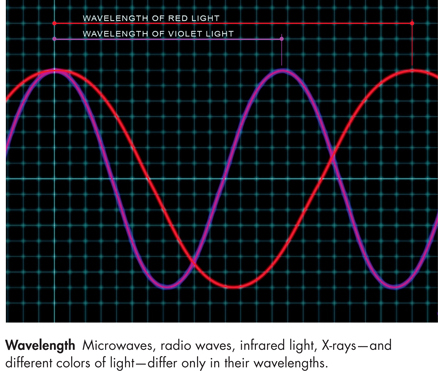
Maxwell’s equations dictate that electromagnetic waves travel at a speed of about 300,000 kilometers a second, or about 670 million miles per hour. But to quote a speed means nothing unless you specify a frame of reference relative to which the speed is measured. That’s not something you usually need to think about in everyday life. When a speed limit sign reads 60 miles per hour, it is understood that your speed is measured relative to the road and not the black hole at the center of the Milky Way. But even in everyday life there are occasions in which you have to take into account reference frames. For example, if you carry a cup of tea up the aisle of a jet plane in flight, you might say your speed is 2 miles per hour. Someone on the ground, however, might say you were moving at 572 miles per hour. Lest you think that one or the other of those observers has a better claim to the truth, keep in mind that because the earth orbits the sun, someone watching you from the surface of that heavenly body would disagree with both and say you are moving at about 18 miles per second, not to mention envying your air-conditioning. In light of such disagreements, when Maxwell claimed to have discovered the “speed of light” popping out of his equations, the natural question was, what is the speed of light in Maxwell’s equations measured relative to?
There is no reason to believe that the speed parameter in Maxwell’s equations is a speed measured relative to the earth. His equations, after all, apply to the entire universe. An alternative answer that was considered for a while is that his equations specify the speed of light relative to a previously undetected medium permeating all space, called the luminiferous ether, or for short, simply the ether, which was Aristotle’s term for the substance he believed filled all of the universe outside the terrestrial sphere. This hypothetical ether would be the medium through which electromagnetic waves propagate, just as sound propagates through air. If the ether existed, there would be an absolute standard of rest (that is, rest with respect to the ether) and hence an absolute way of defining motion as well. The ether would provide a preferred frame of reference throughout the entire universe, against which any object’s speed could be measured. So the ether was postulated to exist on theoretical grounds, setting some scientists off on a search for a way to study it, or at least to confirm its existence. One of those scientists was Maxwell himself.
If you race through the air toward a sound wave, the wave approaches you faster, and if you race away, it approaches you more slowly. Similarly, if there were an ether, the speed of light would vary depending on your motion relative to the ether. In fact, if light worked the way sound does, just as people on a supersonic jet will never hear any sound that emanates from behind the plane, so too would travelers racing quickly enough through the ether be able to outrun a light wave. Working from such considerations, Maxwell suggested an experiment. If there is an ether, the earth must be moving through it as it orbits the sun. And since the earth is traveling in a different direction in January than, say, in April or July, one ought to be able to observe a tiny difference in the speed of light at different times of the year—see the figure below.
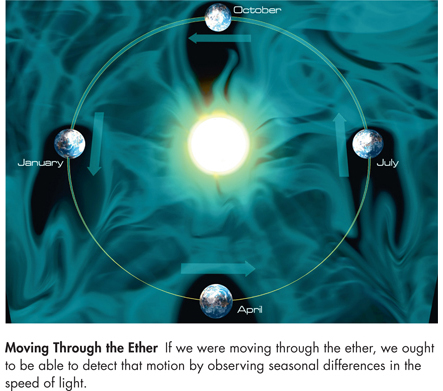
Maxwell was talked out of publishing his idea in Proceedings of the Royal Society by its editor, who didn’t think the experiment would work. But in 1879, shortly before he died at age forty-eight of painful stomach cancer, Maxwell sent a letter on the subject to a friend. The letter was published posthumously in the journal Nature, where it was read by, among others, an American physicist named Albert Michelson. Inspired by Maxwell’s speculation, in 1887 Michelson and Edward Morley carried out a very sensitive experiment designed to measure the speed at which the earth travels through the ether. Their idea was to compare the speed of light in two different directions, at right angles. If the speed of light were a fixed number relative to the ether, the measurements should have revealed light speeds that differed depending on the direction of the beam. But Michelson and Morley observed no such difference.
The outcome of the Michelson and Morley experiment is clearly in conflict with the model of electromagnetic waves traveling through an ether, and should have caused the ether model to be abandoned. But Michelson’s purpose had been to measure the speed of the earth relative to the ether, not to prove or disprove the ether hypothesis, and what he found did not lead him to conclude that the ether didn’t exist. No one else drew that conclusion either. In fact, the famous physicist Sir William Thomson (Lord Kelvin) said in 1884 that the ether was “the only substance we are confident of in dynamics. One thing we are sure of, and that is the reality and substantiality of the luminiferous ether.”
How can you believe in the ether despite the results of the Michelson-Morley experiment? As we’ve said often happens, people tried to save the model by contrived and ad hoc additions. Some postulated that the earth dragged the ether along with it, so we weren’t actually moving with respect to it. Dutch physicist Hendrik Antoon Lorentz and Irish physicist George Francis FitzGerald suggested that in a frame that was moving with respect to the ether, probably due to some yet-unknown mechanical effect, clocks would slow down and distances would shrink, so one would still measure light to have the same speed. Such efforts to save the aether concept continued for nearly twenty years until a remarkable paper by a young and unknown clerk in the patent office in Berne, Albert Einstein.
Einstein was twenty-six in 1905 when he published his paper “Zur Elektrodynamik bewegter Körper” (“On the Electrodynamics of Moving Bodies”). In it he made the simple assumption that the laws of physics and in particular the speed of light should appear to be the same to all uniformly moving observers. This idea, it turns out, demands a revolution in our concept of space and time. To see why, imagine two events that take place at the same spot but at different times, in a jet aircraft. To an observer on the jet there will be zero distance between those two events. But to a second observer on the ground the events will be separated by the distance the jet has traveled in the time between the events. This shows that two observers who are moving relative to each other will not agree on the distance between two events.
Now suppose the two observers observe a pulse of light traveling from the tail of the aircraft to its nose. Just as in the above example, they will not agree on the distance the light has traveled from its emission at the plane’s tail to its reception at the nose. Since speed is distance traveled divided by the time taken, this means that if they agree on the speed at which the pulse travels—the speed of light—they will not agree on the time interval between the emission and the reception.

What makes this strange is that, though the two observers measure different times, they are watching the same physical process. Einstein didn’t attempt to construct an artificial explanation for this. He drew the logical, if startling, conclusion that the measurement of the time taken, like the measurement of the distance covered, depends on the observer doing the measuring. That effect is one of the keys to the theory in Einstein’s 1905 paper, which has come to be called special relativity.
We can see how this analysis could apply to timekeeping devices if we consider two observers looking at a clock. Special relativity holds that the clock runs faster according to an observer who is at rest with respect to the clock. To observers who are not at rest with respect to the clock, the clock runs slower. If we liken a light pulse traveling from the tail to the nose of the plane to the tick of a clock, we see that to an observer on the ground the clock runs slower because the light beam has to travel a greater distance in that frame of reference. But the effect does not depend on the mechanism of the clock; it holds for all clocks, even our own biological ones.
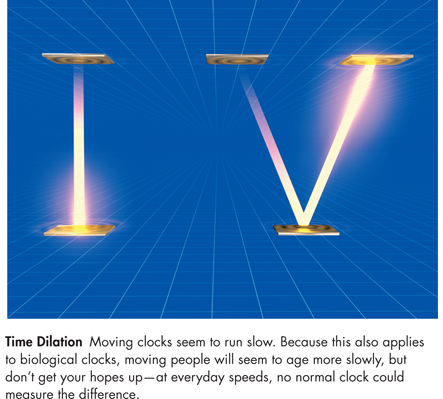
Einstein’s work showed that, like the concept of rest, time cannot be absolute, as Newton thought. In other words, it is not possible to assign to every event a time with which every observer will agree. Instead, all observers have their own measures of time, and the times measured by two observers who are moving relative to each other will not agree. Einstein’s ideas go counter to our intuition because their implications aren’t noticeable at the speeds we normally encounter in everyday life. But they have been repeatedly confirmed by experiment. For example, imagine a reference clock at rest at the center of the earth, another clock on the earth’s surface, and a third clock aboard a plane, flying either with or against the direction of the earth’s rotation. With reference to the clock at the earth’s center, the clock aboard the plane moving eastward—in the direction of the earth’s rotation—is moving faster than the clock on the earth’s surface, and so it should run slower. Similarly, with reference to the clock at the earth’s center, the clock aboard the plane flying westward—against the earth’s rotation—is moving slower than the surface clock, which means that clock should run faster than the clock on the surface. And that is exactly what was observed when, in an experiment performed in October 1971, a very accurate atomic clock was flown around the world. So you could extend your life by constantly flying eastward around the world, though you might get tired of watching all those airline movies. However, the effect is very small, about 180 billionths of a second per circuit (and it is also somewhat lessened by the effects of the difference in gravity, but we need not get into that here).
Due to the work of Einstein, physicists realized that by demanding that the speed of light be the same in all frames of reference, Maxwell’s theory of electricity and magnetism dictates that time cannot be treated as separate from the three dimensions of space. Instead, time and space are intertwined. It is something like adding a fourth direction of future/past to the usual left/right, forward/backward, and up/down. Physicists call this marriage of space and time “space-time,” and because space-time includes a fourth direction, they call it the fourth dimension. In space-time, time is no longer separate from the three dimensions of space, and, loosely speaking, just as the definition of left/right, forward/backward, or up/down depends on the orientation of the observer, so too does the direction of time vary depending on the speed of the observer. Observers moving at different speeds would choose different directions for time in space-time. Einstein’s theory of special relativity was therefore a new model, which got rid of the concepts of absolute time and absolute rest (i.e., rest with respect to the fixed ether).
Einstein soon realized that to make gravity compatible with relativity another change was necessary. According to Newton’s theory of gravity, at any given time objects are attracted to each other by a force that depends on the distance between them at that time. But the theory of relativity had abolished the concept of absolute time, so there was no way to define when the distance between the masses should be measured. Thus Newton’s theory of gravity was not consistent with special relativity and had to be modified. The conflict might sound like a mere technical difficulty, perhaps even a detail that could somehow be worked around without much change in the theory. As it turned out, nothing could have been further from the truth.
Over the next eleven years Einstein developed a new theory of gravity, which he called general relativity. The concept of gravity in general relativity is nothing like Newton’s. Instead, it is based on the revolutionary proposal that space-time is not flat, as had been assumed previously, but is curved and distorted by the mass and energy in it.
A good way to picture curvature is to think of the surface of the earth. Although the earth’s surface is only two-dimensional (because there are only two directions along it, say north/south and east/west), we’re going to use it as our example because a curved two-dimensional space is easier to picture than a curved four-dimensional space. The geometry of curved spaces such as the earth’s surface is not the Euclidean geometry we are familiar with. For example, on the earth’s surface, the shortest distance between two points—which we know as a line in Euclidean geometry—is the path connecting the two points along what is called a great circle. (A great circle is a circle along the earth’s surface whose center coincides with the center of the earth. The equator is an example of a great circle, and so is any circle obtained by rotating the equator along different diameters.)
Imagine, say, that you wanted to travel from New York to Madrid, two cities that are at almost the same latitude. If the earth were flat, the shortest route would be to head straight east. If you did that, you would arrive in Madrid after traveling 3,707 miles. But due to the earth’s curvature, there is a path that on a flat map looks curved and hence longer, but which is actually shorter. You can get there in 3,605 miles if you follow the great-circle route, which is to first head northeast, then gradually turn east, and then southeast. The difference in distance between the two routes is due to the earth’s curvature, and a sign of its non-Euclidean geometry. Airlines know this, and arrange for their pilots to follow great-circle routes whenever practical.
According to Newton’s laws of motion, objects such as cannonballs, croissants, and planets move in straight lines unless acted upon by a force, such as gravity. But gravity, in Einstein’s theory, is not a force like other forces; rather, it is a consequence of the fact that mass distorts space-time, creating curvature. In Einstein’s theory, objects move on geodesics, which are the nearest things to straight lines in a curved space. Lines are geodesics on the flat plane, and great circles are geodesics on the surface of the earth. In the absence of matter, the geodesics in four-dimensional space-time correspond to lines in three-dimensional space. But when matter is present, distorting space-time, the paths of bodies in the corresponding three-dimensional space curve in a manner that in Newtonian theory was explained by the attraction of gravity. When space-time is not flat, objects’ paths appear to be bent, giving the impression that a force is acting on them.
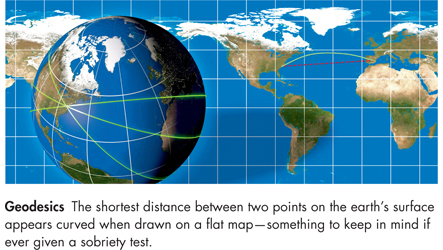
Einstein’s general theory of relativity reproduces special relativity when gravity is absent, and it makes almost the same predictions as Newton’s theory of gravity in the weak-gravity environment of our solar system—but not quite. In fact, if general relativity were not taken into account in GPS satellite navigation systems, errors in global positions would accumulate at a rate of about ten kilometers each day! However, the real importance of general relativity is not its application in devices that guide you to new restaurants, but rather that it is a very different model of the universe, which predicts new effects such as gravitational waves and black holes. And so general relativity has transformed physics into geometry. Modern technology is sensitive enough to allow us to perform many sensitive tests of general relativity, and it has passed every one.
Though they both revolutionized physics, Maxwell’s theory of electromagnetism and Einstein’s theory of gravity—general relativity—are both, like Newton’s own physics, classical theories. That is, they are models in which the universe has a single history. As we saw in the last chapter, at the atomic and subatomic levels these models do not agree with observations. Instead, we have to use quantum theories in which the universe can have any possible history, each with its own intensity or probability amplitude. For practical calculations involving the everyday world, we can continue to use classical theories, but if we wish to understand the behavior of atoms and molecules, we need a quantum version of Maxwell’s theory of electromagnetism; and if we want to understand the early universe, when all the matter and energy in the universe were squeezed into a small volume, we must have a quantum version of the theory of general relativity. We also need such theories because if we are seeking a fundamental understanding of nature, it would not be consistent if some of the laws were quantum while others were classical. We therefore have to find quantum versions of all the laws of nature. Such theories are called quantum field theories.
The known forces of nature can be divided into four classes:
1. Gravity. This is the weakest of the four, but it is a long-range force and acts on everything in the universe as an attraction. This means that for large bodies the gravitational forces all add up and can dominate over all other forces.
2. Electromagnetism. This is also long-range and is much stronger than gravity, but it acts only on particles with an electric charge, being repulsive between charges of the same sign and attractive between charges of the opposite sign. This means the electric forces between large bodies cancel each other out, but on the scales of atoms and molecules they dominate. Electromagnetic forces are responsible for all of chemistry and biology.
3. Weak nuclear force. This causes radioactivity and plays a vital role in the formation of the elements in stars and the early universe. We don’t, however, come into contact with this force in our everyday lives.
4. Strong nuclear force. This force holds together the protons and neutrons inside the nucleus of an atom. It also holds together the protons and neutrons themselves, which is necessary because they are made of still tinier particles, the quarks we mentioned in Chapter 3. The strong force is the energy source for the sun and nuclear power, but, as with the weak force, we don’t have direct contact with it.
The first force for which a quantum version was created was electromagnetism. The quantum theory of the electromagnetic field, called quantum electrodynamics, or QED for short, was developed in the 1940s by Richard Feynman and others, and has become a model for all quantum field theories. As we’ve said, according to classical theories, forces are transmitted by fields. But in quantum field theories the force fields are pictured as being made of various elementary particles called bosons, which are force-carrying particles that fly back and forth between matter particles, transmitting the forces. The matter particles are called fermions. Electrons and quarks are examples of fermions. The photon, or particle of light, is an example of a boson. It is the boson that transmits the electromagnetic force. What happens is that a matter particle, such as an electron, emits a boson, or force particle, and recoils from it, much as a cannon recoils after firing a cannonball. The force particle then collides with another matter particle and is absorbed, changing the motion of that particle. According to QED, all the interactions between charged particles—particles that feel the electromagnetic force—are described in terms of the exchange of photons.
The predictions of QED have been tested and found to match experimental results with great precision. But performing the mathematical calculations required by QED can be difficult. The problem, as we’ll see below, is that when you add to the above framework of particle exchange the quantum requirement that one include all the histories by which an interaction can occur—for example, all the ways the force particles can be exchanged—the mathematics becomes complicated. Fortunately, along with inventing the notion of alternative histories—the way of thinking about quantum theories described in the last chapter—Feynman also developed a neat graphical method of accounting for the different histories, a method that is today applied not just to QED but to all quantum field theories.
Feynman’s graphical method provides a way of visualizing each term in the sum over histories. Those pictures, called Feynman diagrams, are one of the most important tools of modern physics. In QED the sum over all possible histories can be represented as a sum over Feynman diagrams like those below, which represent some of the ways it is possible for two electrons to scatter off each other through the electromagnetic force. In these diagrams the solid lines represent the electrons and the wavy lines represent photons. Time is understood as progressing from bottom to top, and places where lines join correspond to photons being emitted or absorbed by an electron. Diagram (A) represents the two electrons approaching each other, exchanging a photon, and then continuing on their way. That is the simplest way in which two electrons can interact electromagnetically, but we must consider all possible histories. Hence we must also include diagrams like (B). That diagram also pictures two lines coming in—the approaching electrons—and two lines going out—the scattered ones—but in this diagram the electrons exchange two photons before flying off. The diagrams pictured are only a few of the possibilities; in fact, there are an infinite number of diagrams, which must be mathematically accounted for.
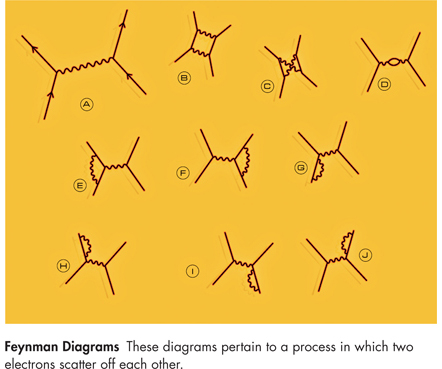
Feynman diagrams aren’t just a neat way of picturing and categorizing how interactions can occur. Feynman diagrams come with rules that allow you to read off, from the lines and vertices in each diagram, a mathematical expression. The probability, say, that the incoming electrons, with some given initial momentum, will end up flying off with some particular final momentum is then obtained by summing the contributions from each Feynman diagram. That can take some work, because, as we’ve said, there are an infinite number of them. Moreover, although the incoming and outgoing electrons are assigned a definite energy and momentum, the particles in the closed loops in the interior of the diagram can have any energy and momentum. That is important because in forming the Feynman sum one must sum not only over all diagrams but also over all those values of energy and momentum.
Feynman diagrams provided physicists with enormous help in visualizing and calculating the probabilities of the processes described by QED. But they did not cure one important ailment suffered by the theory: When you add the contributions from the infinite number of different histories, you get an infinite result. (If the successive terms in an infinite sum decrease fast enough, it is possible for the sum to be finite, but that, unfortunately, doesn’t happen here.) In particular, when the Feynman diagrams are added up, the answer seems to imply that the electron has an infinite mass and charge. This is absurd, because we can measure the mass and charge and they are finite. To deal with these infinities, a procedure called renormalization was developed.
The process of renormalization involves subtracting quantities that are defined to be infinite and negative in such a way that, with careful mathematical accounting, the sum of the negative infinite values and the positive infinite values that arise in the theory almost cancel out, leaving a small remainder, the finite observed values of mass and charge. These manipulations might sound like the sort of things that get you a flunking grade on a school math exam, and renormalization is indeed, as it sounds, mathematically dubious. One consequence is that the values obtained by this method for the mass and charge of the electron can be any finite number. That has the advantage that physicists may choose the negative infinities in a way that gives the right answer, but the disadvantage that the mass and charge of the electron therefore cannot be predicted from the theory. But once we have fixed the mass and charge of the electron in this manner, we can employ QED to make many other very precise predictions, which all agree extremely closely with observation, so renormalization is one of the essential ingredients of QED. An early triumph of QED, for example, was the correct prediction of the so-called Lamb shift, a small change in the energy of one of the states of the hydrogen atom discovered in 1947.
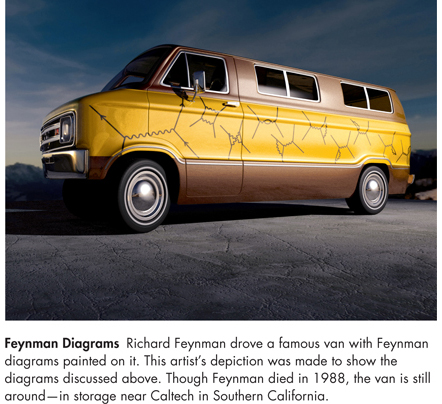
The success of renormalization in QED encouraged attempts to look for quantum field theories describing the other three forces of nature. But the division of natural forces into four classes is probably artificial and a consequence of our lack of understanding. People have therefore sought a theory of everything that will unify the four classes into a single law that is compatible with quantum theory. This would be the holy grail of physics.
One indication that unification is the right approach came from the theory of the weak force. The quantum field theory describing the weak force on its own cannot be renormalized; that is, it has infinities that cannot be canceled by subtracting a finite number of quantities such as mass and charge. However, in 1967 Abdus Salam and Steven Weinberg each independently proposed a theory in which electromagnetism was unified with the weak force, and found that the unification cured the plague of infinities. The unified force is called the electroweak force. Its theory could be renormalized, and it predicted three new particles called W+, W–, and Z0. Evidence for the Z0 was discovered at CERN in Geneva in 1973. Salam and Weinberg were awarded the Nobel Prize in 1979, although the W and Z particles were not observed directly until 1983.
The strong force can be renormalized on its own in a theory called QCD, or quantum chromodynamics. According to QCD, the proton, the neutron, and many other elementary particles of matter are made of quarks, which have a remarkable property that physicists have come to call color (hence the term “chromodynamics,” although quark colors are just helpful labels—there is no connection with visible color). Quarks come in three so-called colors, red, green, and blue. In addition, each quark has an anti-particle partner, and the colors of those particles are called anti-red, anti-green, and anti-blue. The idea is that only combinations with no net color can exist as free particles. There are two ways to achieve such neutral quark combinations. A color and its anti-color cancel, so a quark and an anti-quark form a colorless pair, an unstable particle called a meson. Also, when all the three colors (or anti-colors) are mixed, the result has no net color. Three quarks, one of each color, form stable particles called baryons, of which protons and neutrons are examples (and three anti-quarks form the anti-particles of the baryons). Protons and neutrons are the baryons that make up the nucleus of atoms and are the basis for all normal matter in the universe.
QCD also has a property called asymptotic freedom, which we referred to, without naming it, in Chapter 3. Asymptotic freedom means that the strong forces between quarks are small when the quarks are close together but increase if they are farther apart, rather as though they were joined by rubber bands. Asymptotic freedom explains why we don’t see isolated quarks in nature and have been unable to produce them in the laboratory. Still, even though we cannot observe individual quarks, we accept the model because it works so well at explaining the behavior of protons, neutrons, and other particles of matter.
After uniting the weak and electromagnetic forces, physicists in the 1970s looked for a way to bring the strong force into that theory. There are a number of so-called grand unified theories or GUTs that unify the strong forces with the weak force and electromagnetism, but they mostly predict that protons, the stuff that we are made of, should decay, on average, after about 1032 years. That is a very long lifetime, given that the universe is only about 1010 years old. But in quantum physics, when we say the average lifetime of a particle is 1032 years, we don’t mean that most particles live approximately 1032 years, some a bit more and some a bit less. Instead, what we mean is that, each year, the particle has a 1 in 1032 chance of decaying. As a result, if you watch a tank containing 1032 protons for just a few years, you ought to see some of the protons decay. It is not too hard to build such a tank, since 1032 protons are contained in just a thousand tons of water. Scientists have performed such experiments. It turns out that detecting the decays and differentiating them from other events caused by the cosmic rays that continually shower us from space is no easy matter. To minimize the noise, the experiments are carried out deep inside places such as the Kamioka Mining and Smelting Company’s mine 3,281 feet under a mountain in Japan, which is somewhat shielded from cosmic rays. As a result of observations in 2009, researchers have concluded that if protons decay at all, the proton lifetime is greater than about 1034 years, which is bad news for grand unified theories.
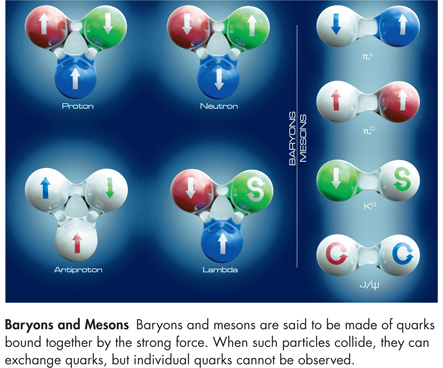
Since earlier observational evidence had also failed to support GUTs, most physicists adopted an ad hoc theory called the standard model, which comprises the unified theory of the electroweak forces and QCD as a theory of the strong forces. But in the standard model, the electroweak and strong forces act separately and are not truly unified. The standard model is very successful and agrees with all current observational evidence, but it is ultimately unsatisfactory because, apart from not unifying the electroweak and strong forces, it does not include gravity.
It may have proved difficult to meld the strong force with the electromagnetic and weak forces, but those problems are nothing compared with the problem of merging gravity with the other three, or even of creating a stand-alone quantum theory of gravity. The reason a quantum theory of gravity has proven so hard to create has to do with the Heisenberg uncertainty principle, which we discussed in Chapter 4. It is not obvious, but it turns out that with regard to that principle, the value of a field and its rate of change play the same role as the position and velocity of a particle. That is, the more accurately one is determined, the less accurately the other can be. An important consequence of that is that there is no such thing as empty space. That is because empty space means that both the value of a field and its rate of change are exactly zero. (If the field’s rate of change were not zero, the space would not remain empty.) Since the uncertainty principle does not allow the values of both the field and the rate of change to be exact, space is never empty. It can have a state of minimum energy, called the vacuum, but that state is subject to what are called quantum jitters, or vacuum fluctuations—particles and fields quivering in and out of existence.
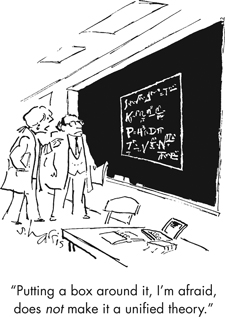
One can think of the vacuum fluctuations as pairs of particles that appear together at some time, move apart, then come together and annihilate each other. In terms of Feynman diagrams, they correspond to closed loops. These particles are called virtual particles. Unlike real particles, virtual particles cannot be observed directly with a particle detector. However, their indirect effects, such as small changes in the energy of electron orbits, can be measured, and agree with theoretical predictions to a remarkable degree of accuracy. The problem is that the virtual particles have energy, and because there are an infinite number of virtual pairs, they would have an infinite amount of energy. According to general relativity, this means that they would curve the universe to an infinitely small size, which obviously does not happen!
This plague of infinities is similar to the problem that occurs in the theories of the strong, weak, and electromagnetic forces, except in those cases renormalization removes the infinities. But the closed loops in the Feynman diagrams for gravity produce infinities that cannot be absorbed by renormalization because in general relativity there are not enough renormalizable parameters (such as the values of mass and charge) to remove all the quantum infinities from the theory. We are therefore left with a theory of gravity that predicts that certain quantities, such as the curvature of space-time, are infinite, which is no way to run a habitable universe. That means the only possibility of obtaining a sensible theory would be for all the infinities to somehow cancel, without resorting to renormalization.
In 1976 a possible solution to that problem was found. It is called supergravity. The prefix “super” was not appended because physicists thought it was “super” that this theory of quantum gravity might actually work. Instead, “super” refers to a kind of symmetry the theory possesses, called supersymmetry.
In physics a system is said to have a symmetry if its properties are unaffected by a certain transformation such as rotating it in space or taking its mirror image. For example, if you flip a donut over, it looks exactly the same (unless it has a chocolate topping, in which case it is better just to eat it). Supersymmetry is a more subtle kind of symmetry that cannot be associated with a transformation of ordinary space. One of the important implications of supersymmetry is that force particles and matter particles, and hence force and matter, are really just two facets of the same thing. Practically speaking, that means that each matter particle, such as a quark, ought to have a partner particle that is a force particle, and each force particle, such as the photon, ought to have a partner particle that is a matter particle. This has the potential to solve the problem of infinities because it turns out that the infinities from closed loops of force particles are positive while the infinities from closed loops of matter particles are negative, so the infinities in the theory arising from the force particles and their partner matter particles tend to cancel out. Unfortunately, the calculations required to find out whether there would be any infinities left uncanceled in supergravity were so long and difficult and had such potential for error that no one was prepared to undertake them. Most physicists believed, nonetheless, that supergravity was probably the right answer to the problem of unifying gravity with the other forces.
You might think that the validity of supersymmetry would be an easy thing to check—just examine the properties of the existing particles and see if they pair up. No such partner particles have been observed. But various calculations that physicists have performed indicate that the partner particles corresponding to the particles we observe ought to be a thousand times as massive as a proton, if not even heavier. That is too heavy for such particles to have been seen in any experiments to date, but there is hope that such particles will eventually be created in the Large Hadron Collider in Geneva.
The idea of supersymmetry was the key to the creation of supergravity, but the concept had actually originated years earlier with theorists studying a fledgling theory called string theory. According to string theory, particles are not points, but patterns of vibration that have length but no height or width—like infinitely thin pieces of string. String theories also lead to infinities, but it is believed that in the right version they will all cancel out. They have another unusual feature: They are consistent only if space-time has ten dimensions, instead of the usual four. Ten dimensions might sound exciting, but they would cause real problems if you forgot where you parked your car. If they are present, why don’t we notice these extra dimensions? According to string theory, they are curved up into a space of very small size. To picture this, imagine a two-dimensional plane. We call the plane two-dimensional because you need two numbers (for instance, horizontal and vertical coordinates) to locate any point on it. Another two-dimensional space is the surface of a straw. To locate a point on that space, you need to know where along the straw’s length the point is, and also where along its circular dimension. But if the straw is very thin, you would get a very good approximate position employing only the coordinate that runs along the straw’s length, so you might ignore the circular dimension. And if the straw were a million-million-million-million-millionth of an inch in diameter, you wouldn’t notice the circular dimension at all. That is the picture string theorists have of the extra dimensions—they are highly curved, or curled, on a scale so small that we don’t see them. In string theory the extra dimensions are curled up into what is called the internal space, as opposed to the three-dimensional space that we experience in everyday life. As we’ll see, these internal states are not just hidden dimensions swept under the rug—they have important physical significance.
In addition to the question of dimensions, string theory suffered from another awkward issue: There appeared to be at least five different theories and millions of ways the extra dimensions could be curled up, which was quite an embarrassment of possibilities for those advocating that string theory was the unique theory of everything. Then, around 1994, people started to discover dualities—that different string theories, and different ways of curling up the extra dimensions, are simply different ways of describing the same phenomena in four dimensions. Moreover, they found that supergravity is also related to the other theories in this way. String theorists are now convinced that the five different string theories and supergravity are just different approximations to a more fundamental theory, each valid in different situations.
That more fundamental theory is called M-theory, as we mentioned earlier. No one seems to know what the “M” stands for, but it may be “master,” “miracle,” or “mystery.” It seems to be all three. People are still trying to decipher the nature of M-theory, but that may not be possible. It could be that the physicist’s traditional expectation of a single theory of nature is untenable, and there exists no single formulation. It might be that to describe the universe, we have to employ different theories in different situations. Each theory may have its own version of reality, but according to model-dependent realism, that is acceptable so long as the theories agree in their predictions whenever they overlap, that is, whenever they can both be applied.
Whether M-theory exists as a single formulation or only as a network, we do know some of its properties. First, M-theory has eleven space-time dimensions, not ten. String theorists had long suspected that the prediction of ten dimensions might have to be adjusted, and recent work showed that one dimension had indeed been overlooked. Also, M-theory can contain not just vibrating strings but also point particles, two-dimensional membranes, three-dimensional blobs, and other objects that are more difficult to picture and occupy even more dimensions of space, up to nine. These objects are called p-branes (where p runs from zero to nine).

What about the enormous number of ways to curl up the tiny dimensions? In M-theory those extra space dimensions cannot be curled up in just any way. The mathematics of the theory restricts the manner in which the dimensions of the internal space can be curled. The exact shape of the internal space determines both the values of physical constants, such as the charge of the electron, and the nature of the interactions between elementary particles. In other words, it determines the apparent laws of nature. We say “apparent” because we mean the laws that we observe in our universe—the laws of the four forces, and the parameters such as mass and charge that characterize the elementary particles. But the more fundamental laws are those of M-theory.
The laws of M-theory therefore allow for different universes with different apparent laws, depending on how the internal space is curled. M-theory has solutions that allow for many different internal spaces, perhaps as many as 10500, which means it allows for 10500 different universes, each with its own laws. To get an idea how many that is, think about this: If some being could analyze the laws predicted for each of those universes in just one millisecond and had started working on it at the big bang, at present that being would have studied just 1020 of them. And that’s without coffee breaks.
Centuries ago Newton showed that mathematical equations could provide a startlingly accurate description of the way objects interact, both on earth and in the heavens. Scientists were led to believe that the future of the entire universe could be laid out if only we knew the proper theory and had enough computing power. Then came quantum uncertainty, curved space, quarks, strings, and extra dimensions, and the net result of their labor is 10500 universes, each with different laws, only one of which corresponds to the universe as we know it. The original hope of physicists to produce a single theory explaining the apparent laws of our universe as the unique possible consequence of a few simple assumptions may have to be abandoned. Where does that leave us? If M-theory allows for 10500 sets of apparent laws, how did we end up in this universe, with the laws that are apparent to us? And what about those other possible worlds?